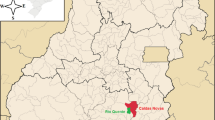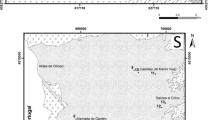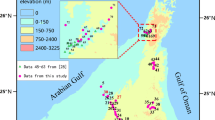Abstract
The article is devoted to assessing the radiation quality formation of groundwater with anomalous excesses of 234U on example the Pre-Volga region (European part of Russia). It was found that exceeding the reference values of groundwater radiological toxicity in a number of cases is associated with anomalously high activity of 234U. Isotopic (2H, 18O) and chemical data indicate that the anomalous 234U/238U ratios are of cryogenic origin related to the effects of past climatic fluctuations on the aquifers. Such groundwater formed from thawed permafrost at extremely low uranium concentrations may have unsatisfactory radiological quality due to anomalous excesses of 234U.






Similar content being viewed by others
Data availability
The datasets presented in this study can be obtained upon request to the corresponding author.
References
Darby S, Hill D, Auvinen A, Barros–Dios JM, Baysson H, Bochicchio F (2005) Radon in homes and risk of lung cancer: collaborative analysis of individual data from 13 European case−control studies. BMJ 330:223. https://doi.org/10.1136/bmj.38308.477650.63
Zeeb H, Shannoun F (2009) World health organization handbook in indoor radon: a public health perspective. WHO, Brazil (in Portuguese)
Onishchenko A, Zhukovsky M, Veselinovic N, Zunic Z (2010) Radium−226 concentration in spring water sampled in high radon regions. Appl Radiat Isot 68:825–827. https://doi.org/10.1016/j.apradiso.2009.09.050
Canu IG, Laurent O, Pires N, Laurier D, Dublineau I (2011) Health effects of naturally radioactive water ingestion: the need for enhanced studies. Environ Health Perspect 119(12):1676–1680. https://doi.org/10.1289/ehp.1003224
Szabo Z, Paul V, Fischer J, Kraemer T, Jacobsen E (2012) Occurrence and geochemistry of radium in water from principal drinking−water aquifer systems of the United States. Appl Geochem 27:729–752. https://doi.org/10.1016/j.apgeochem.2011.11.002
Keramati H, Ghorbani R, Fakhri Y, Khaneghah AM (2018) Radon−222 in drinking water resources of Iran: a systematic review, meta−analysis and probabilistic risk assessment (Monte Carlo simulation). Food Chem Toxicol 115:460–469. https://doi.org/10.1016/j.fct.2018.03.042
Chmielewska I, Chałupnik S, Wysocka M, Smoliński A (2020) Radium measurements in bottled natural mineral−, spring− and medicinal waters from Poland. Water Resour Ind 24:100133. https://doi.org/10.1016/j.wri.2020.100133
Lee K, Ko K (2021) Measurement of radium and radon in water using a combination technique of radon−emanation and pair−measurements methods. Appl Radiat Isot 178:109950. https://doi.org/10.1016/j.apradiso.2021.109950
Sherif MI, Sturchio NC (2021) Elevated radium levels in Nubian Aquifer groundwater of Northeastern Africa. Sci Rep 11:78. https://doi.org/10.1038/s41598−020−80160−0
Amaral R, Júnior J, Fernández Z, Melo N (2022) Risk survey for the population of Recife and neighboring cities due to the occurrence of radium in groundwater. J Environ Radioact 247:106868. https://doi.org/10.1016/j.jenvrad.2022.106868
Su Z, Jia X, Fan Y, Zhao F, Zhou Q, Taylor P, Qiao Y (2022) Quantitative evaluation of radon, tobacco use and lung cancer association in an occupational cohort with 27 follow−up years. Ecotoxicol Environ Saf 232:113233. https://doi.org/10.1016/j.ecoenv.2022.113233
Lei B, Zhao L, Girault F, Cai Z, Luo C, Thapa S, She J, Perrier F (2023) Overview and large−scale representative estimate of radon−222 flux data in China. Environ Advances 11:100312. https://doi.org/10.1016/j.envadv.2022.100312
WHO (World Health Organization) (2017) Guidelines for drinking−water quality. World Health Organization, Geneva
Bonotto D, Wijesiri B, Goonetilleke A (2019) Nitrate−dependent Uranium mobilisation in groundwater. Sci Total Environ 693:133655. https://doi.org/10.1016/j.scitotenv.2019.133655
NRB–99/2009 (2009) Radiation safety standards. Ministry of Health of Russia, Moscow
Ho PL, Hung LD, Minh VT (2020) Simultaneous determination of gross alpha/beta activities in groundwater for ingestion effective dose and its associated public health risk prevention. Sci Rep 10:4299. https://doi.org/10.1038/s41598−020−61203−y
Smedley PL, Kinniburgh DG (2023) Uranium in natural waters and the environment: distribution, speciation and impact. Appl Geochem 148:105534. https://doi.org/10.1016/j.apgeochem.2022.105534
USEPA (United States Environmental Protection Agency) (1980) Prescribed procedures for measurement of radioactivity in drinking water. Gross Alpha and Gross Beta Radioactivity in Drinking Water (EPA/600/4−80−032). Washington DC
USEPA (United States Environmental Protection Agency) (1986) SW−846 test method 9310: gross alpha and gross beta. Washington DC
UKEA (United Kingdom Environment Agency) (1985) Methods for the examination of waters and associated materials. In: Measurement of alpha and beta activity of water and sludge samples. London
AS 3550.5 (1990) Waters–determination of gross alpha and gross beta activities. Australian Standard, Sydney
APHA/AWWA/WEF (American Public Health Association, American Water Works Association, Water Environment Federation) (1998) Standards methods for the examination of water and wastewater, 19th ed. Washington DC
GOST 51730−2001 (2001) Drinking water. Method for determination of summary specific radio−nuclei alpha−activity. Moscow (in Russian)
VIMS (2009) Total activity of alpha−and beta−emitting radionuclides in natural waters (fresh and mineralized). Sample preparation and measurement. Guidelines. Moscow (in Russian)
USEPA (United States Environmental Protection Agency) (2009) Drinking water regulations and contaminants–national primary drinking water regulations (EPA 816−F−09−000). Washington DC
Guidelines 2.6.1.2719−10 (2010) Radiation control and hygienic assessment of sources of drinking water supply and drinking water in terms of radiation safety. Moscow (in Russian)
ISO 9697−2016 (2016) Water quality. Gross beta activity in drinking water. Thick source method. Minsk (in Russian)
ISO 9696−2017 (2017). Water quality. Gross alpha activity. Test method using thick source.
Banning A, Benfer M (2017) Drinking water uranium and potential health effects in the German Federal state of Bavaria. Int J Environ Res Public Health 14(8):927. https://doi.org/10.3390/ijerph14080927
Sarvajayakesavalu S, Lakshminarayanan D, George J, Magesh SB, Anilkumar KM, Brammanandhan GM, Chandrasekara A, Ravikumar M (2018) Geographic information system mapping of gross alpha/beta activity concentrations in ground water samples from Karnataka, India: a preliminary study. Groundw Sustain Dev 6:164–168. https://doi.org/10.1016/j.gsd.2017.12.003
Sahoo SK, Jha VN, Patra AC, Jha SK, Kulkarni MS (2020) Scientific background and methodology adopted on derivation of regulatory limit for uranium in drinking water–a global perspective. Environ Adv 2:100020. https://doi.org/10.1016/j.envadv.2020.100020
Balaram V, Rani A, Rathore DPS (2022) Uranium in groundwater in parts of India and world: a comprehensive review of sources, impact to the environment and human health, analytical techniques, and mitigation technologies. Geosyst Geoenviron 1(2):100043. https://doi.org/10.1016/j.geogeo.2022.100043
Zamora ML, Tracy BL, Zielinski JM, Meyerhof DP, Moss MA (1998) Chronic ingestion of uranium in drinking water: a study of kidney bioeffects in humans. Toxicol Sci 43:68–77. https://doi.org/10.1093/toxsci/43.1.68
Kurttio P, Auvinen A, Salonen L, Saha H, Pekkanen J, Mäkeläinen I (2002) Renal effects of uranium in drinking water. Environ Health Perspect 110(4):337–342. https://doi.org/10.1289/ehp.02110337
Ma M, Wang R, Xu L, Xu M, Liu S (2020) Emerging health risks and underlying toxicological mechanisms of uranium contamination: lessons from the past two decades. Environ Int 145:106107. https://doi.org/10.1016/j.envint.2020.106107
Kumar A, Arora T, Singh P, Singh K, Singh D, Pathak P, Ramola R (2021) Quantification of radiological dose and chemical toxicity due to radon and uranium in drinking water in Bageshwar region of Indian Himalaya. Groundw Sustain Dev 12:100491. https://doi.org/10.1016/j.gsd.2020.100491
Ramesh R, Subramanian M, Lakshmanan E, Subramaniyan A, Gowrisankar G (2021) Human health risk assessment using Monte Carlo simulations for groundwater with uranium in southern India. Ecotoxicol Environ Saf 226:112781. https://doi.org/10.1016/j.ecoenv.2021.112781
Sahu M, Kumar S, Baghel T, Dewangan R (2020) Seasonal and geochemical variation of uranium and major ions in groundwater at Kanker district of Chhattisgarh, central India. Groundw Sustain Dev 10:100330. https://doi.org/10.1016/j.gsd.2020.100330
Nolan J, Weber KA (2015) Natural uranium contamination in major U.S. aquifers linked to nitrate. Environ Sci Technol Lett 2(8):215–220. https://doi.org/10.1021/acs.estlett.5b00174
Eross A, Csondor K, Izsak B, Vargha M, Horváth Á, Pándics T (2018) Uranium in groundwater–the importance of hydraulic regime and groundwater flow system’s understanding. J Environ Radioact 195:90–96. https://doi.org/10.1016/j.jenvrad.2018.10.002
Makubalo SS, Diamond RE (2020) Hydrochemical evolution of high uranium, fluoride and nitrate groundwaters of Namakwaland. South Africa J Afr Earth Sci 172:104002. https://doi.org/10.1016/j.jafrearsci.2020.104002
Prakash R, Bhartariya KG, Singh S (2020) Uranium and Its correlation with other geogenic contaminants in ground water of Ganga Yamuna Doab, Fatehpur District, Uttar Pradesh, India. J Geol Soc India 95:359–365. https://doi.org/10.1007/s12594−020−1444−x
Mathuthu M, Uushona V, Indongo V (2021) Radiological safety of groundwater around a uranium mine in Namibia. Phys Chem Earth 122:102915. https://doi.org/10.1016/j.pce.2020.102915
Bala R, Karanveer D (2022) Occurrence and behaviour of uranium in the groundwater and potential health risk associated in semi−arid region of Punjab. India Groundw Sustain Dev 17:100731. https://doi.org/10.1016/j.gsd.2022.100731
Dwivedi D, Steefel CI, Arora B, Banfield J, Bargar J (2022) From legacy contamination to watershed systems science: a review of scientific insights and technologies developed through DOE−supported research in water and energy security. Environ Res Lett 17(4):043004. https://doi.org/10.1088/1748−9326/ac59a9
Khurelbaatar L, Batdelger A, Khinayat T, Oyuntsetseg B (2022) Pattern recognition method from hydrochemical parameters to predict uranium concentrations in groundwater. Chemometr Intell Lab Syst 222:104509. https://doi.org/10.1016/j.chemolab.2022.104509
Pushparaj GT, Sampath PV, Maliyekkal SM (2022) A critical review of uranium contamination in groundwater: treatment and sludge disposal. Sci Total Environ 825:15394. https://doi.org/10.1016/j.scitotenv.2022.153947
Papageorgiou F, McDermott F, Van Acken D (2022) Uranium in groundwaters: insights from the Leinster granite. SE Ireland Appl Geochem 139:105236. https://doi.org/10.1016/j.apgeochem.2022.105236
Sharma DA, Keesari T, Pant D, Rishi MS, Sangwan P, Thakur N, Sinha UK (2022) Appraising the factors favouring uranium mobilization and associated health risk assessment in groundwaters of north−western India. Ecotoxicol Environ Saf 229:113086. https://doi.org/10.1016/j.ecoenv.2021.113086
Cherdyntsev VV (1969) Uranium−234. Atomizdat, Moscow (in Russian)
Chalov PI (1975) Isotopic fractionation of natural uranium. Frunze (in Russian)
Andrews JN, Ford DJ, Hussain N, Trivedi D, Youngman MJ (1989) Natural radioelement solution by circulating groundwaters in the Stripa granite. Geochim Cosmochim Acta 53:1791–1802
Grabowski P, Bem H (2012) Uranium isotopes as a tracer of groundwater transport studies. J Radioanal Nucl Chem 292(3):1043–1048. https://doi.org/10.1007/s10967−011−1558−0
Nordberg GF, Fowler BA, Nordberg M, Friberg LT (2007) Handbook of the toxicology of metals. Elsevier, Amsterdam. https://doi.org/10.1016/B978−0−12−369413−3.X5052−6
Keith S, Faroon O, Roney N (2013) Toxicological profile for uranium. Agency for toxic substances and disease registry (US)
Sofield RM, Kantar C (2013) Uranium. Reference module in earth systems and environmental sciences. Elsevier, Amsterdam. https://doi.org/10.1016/B978−0−12−409548−9.00804−6
Silva ML, Bonotto DM (2015) Uranium isotopes in groundwater occurring at Amazonas State, Brazil. Appl Radiat Isot 97:24–33. https://doi.org/10.1016/j.apradiso.2014.12.012
Thang NV, Thu HNP, Hao LC (2022) Uranium isotopes in groundwater in Ho Chi Minh City and related issues: health risks, environmental effects, and mitigation methods. J Contam Hydrol 245:103941. https://doi.org/10.1016/j.jconhyd.2021.103941
Vengosh A, Coyte R, Podgorski J, Johnson T (2022) A critical review on the occurrence and distribution of the uranium−and thorium−decay nuclides and their effect on the quality of groundwater. Sci Total Environ 808:151914. https://doi.org/10.1016/j.scitotenv.2021.151914
Bakhur AE (2009) Scientific and methodological bases of radioecological assessment of geological environment. VIMS, Moscow (in Russian)
Abdul–Hadi A, Alhassanieh O, Ghafar M (2001) Disequilibrium of uranium isotopes in some Syrian groundwater. Appl Radiat Isot 55(1):109–113. https://doi.org/10.1016/S0969−8043(00)00369−9
Lee MH, Choi GS, Cho YH, Lee CW, Shin HS (2001) Concentrations and activity ratios of uranium isotopes in the groundwater of the Okchun Belt in Korea. J Environ Radioact 57(2):105–116. https://doi.org/10.1016/S0265−931X(01)00014−5
Chabaux F, Riotte J (2003) U−Th−Ra fractionation during weathering and river transport. Rev Mineral Geochem 52(1):533–576. https://doi.org/10.2113/0520533
Goldstein SJ, Abdel–Fattah AI, Murrell MT, Dobson PF, Norman DE, Amato RS, Nunn AJ (2010) Uranium−series constraints on radionuclide transport and groundwater flow at the Nopal I uranium deposit, Sierra Peña Blanca, Mexico. Environ Sci Technol 44(5):1579–1586. https://doi.org/10.1021/es902689e
Wang R, You C (2013) Uranium and strontium isotopic evidence for strong submarine groundwater discharge in an estuary of a mountainous island: a case study in the Gaoping River Estuary, Southwestern Taiwan. Mar Chem 157:106–116. https://doi.org/10.1016/j.marchem.2013.09.004
Paces JB, Wurster FC (2014) Natural uranium and strontium isotope tracers of water sources and surface water−groundwater interactions in arid wetlands–Pahranagat Valley, Nevada, USA. J Hydrol 517:213–225. https://doi.org/10.1016/j.jhydrol.2014.05.011
Noli F, Kazakis N, Vargemezis G, Ioannidou A (2016) The uranium isotopes in the characterisation of groundwater in the Thermi−Vasilika region, northern Greece. Isot Environ Health Stud 52:405–413. https://doi.org/10.1080/10256016.2015.1119134
Guerrero JL, Vallejos Á, Cerón JC, Sánchez–Martos F, Pulido–Bosch A, Bolívar JP (2016) U−isotopes and 226Ra as tracers of hydrogeochemical processes in carbonated karst aquifers from arid areas. J Environ Radioact 158–159:9–20. https://doi.org/10.1016/j.jenvrad.2016.03.015
Dhaoui Z, Chkir N, Zouari K, Hadj A, Agoune A (2016) Investigation of uranium geochemistry along groundwater flow path in the Continental Intercalaire aquifer (Southern Tunisia). J Environ Radioact 157:67–76. https://doi.org/10.1016/j.jenvrad.2016.03.005
El Sharkawy AM (2018) 234U/238U activity ratios in groundwaters from two aquifers in Saudi Arabia, and correlation with water chemistry. J Radiat Res Appl Sci 11(4):368–372. https://doi.org/10.1016/j.jrras.2018.07.005
Ammar F, Deschamps P, Chkir N, Zouari K, Agoune A, Hamelin B (2020) Uranium isotopes as tracers of groundwater evolution in the complexe terminal aquifer of southern Tunisia. Quat Int 547:33–49. https://doi.org/10.1016/j.quaint.2020.01.024
Milena–Perez FP, Benavente J, Expósito–Suarez VM, Vacas–Arquero P, Ferro–García MA (2021) Uranium content and uranium isotopic disequilibria as a tool to identify hydrogeochemical processes. J Environ Radioact 227:106503. https://doi.org/10.1016/j.jenvrad.2020.106503
Kazakis N, Busico G, Ntona M, Philippou K (2022) The origin of Uranium in groundwater of the eastern Halkidiki region, northern Greece. Sci Total Environ 812:152445. https://doi.org/10.1016/j.scitotenv.2021.152445
Fallatah O, Khattab MR (2023) Determination of uranium concentrations and 234U/238U isotopic ratios in plants and the groundwater used in their cultivation in an area with high background radiation. Sustainability 15:1590. https://doi.org/10.3390/su15021590
Kaduka MV, Basalaeva LN, Bekyasheva TA, Ivanov SA, Salazkina NV, Stupina VV, Kaduka AN (2018) The content of uranium isotopes in the underground water sources of the population of Leningrad Region and St. Petersburg. Radiat Hyg 11(3):74–82. https://doi.org/10.21514/1998−426X−2018−11−3−74−82
Tokarev IV, Zubkov AA, Rumynin VG, Pozdnyakov SP, Polyakov VA, Kuznetsov VYu (2009) Assessment of the long−term safety of radioactive waste disposal: 1. Paleoreconstruction of groundwater formation conditions. Water Resour 36(2):206–213
Ezhova M, Polyakov V, Tkachenko A, Savitsky L, Belkina V (1996) Paleogeologists of North Estonia and their impact on changes in the resources and quality of fresh groundwater in large coastal bodies of water. Geology 19:37–40
Mokrik R, Samalavičius V (2022) Interpretation of the anomalous groundwater chemistry and 234U/238U activity ratio disequilibrium in the northern part of the Baltic region. Lith J Phys 62(1):21–43. https://doi.org/10.3952/physics.v62i1.4645
Ulengov RA (2016) Physical geography of the Republic of Tatarstan. Kazan Federal University, Kazan (in Russian)
Nuriev IS (2010) Features of the formation of the chemical composition of groundwater of the active water exchange zone of the south−west of Tatarstan. Kazan State University, Kazan (in Russian)
MRT (2022) State report on the state of natural resources and environmental protection of the Republic of Tatarstan in 2021. Minprirody RT, Kazan (in Russian)
Gorshkova AT, Urbanova ON, Bortnikova NV, Pavlova OV, Valetdinov AR (2017) Dynamics of change in the character of surface runoff formation of the Western Precambrian region of the Republic of Tatarstan. Evolut Dyn Ecosyst 1–2:55 ((in Russian))
Urquhart C, Gore AJP (1973) The redox characteristics of four peat profiles. Soil Biol Biochem 5:659–672. https://doi.org/10.1016/0038−0717(73)90056−4
VIMS (2013) Methods for measuring the volumetric activity of uranium isotopes (238U, 234U, 235U) in samples of natural (fresh and mineralized), technological and waste waters by alpha−spectrometric method with radiochemical preparation. All−Russian Mineral Resources Research Institute, VIMS, Moscow (in Russian)
Palmer MR, Edmond JM (1993) Uranium in river water. Geochim Cosmochim Acta 57(20):4947–4955. https://doi.org/10.1016/0016−7037(93)90131−F
Yudin SS (2008) On some features of uranium behavior in the river net of the Azov Sea Basin. Izvestiya vuzov. North Cauc Region 6(148):115–118 ((in Russian))
Amrane M, Oufni L (2017) Determination for levels of uranium and thorium in water along Oum Er−Rabia river using alpha track detectors. J Radiat Res Appl Sci 10(3):246–251. https://doi.org/10.1016/j.jrras.2017.05.002
Sharifullin AN, Mozzherin VI, Mozzherin VV, Dvinskikh AP, Denmukhametov RR, Kurbanova SG (2008) Evaluation of the underground feeding of rivers and springs of the Republic of Tatarstan. Nauchnye zapiski Kazanskogo Gosudarstvennogo Universiteta. Series Nat Sci 150(4):67–76 ((in Russian))
Kiselev GP (1999) Even isotopes of uranium in the geosphere. UrB RAS, Yekaterinburg (in Russian)
Rikhvanov LP (2009) Radioactive elements in the environment and the problems of radioecology: a training manual. Tomsk Polytechnic University, Tomsk (in Russian)
Shvartsev SL (1998) Hydrogeochemistry of hypergenesis zone. Nedra, Moscow (in Russian)
Yakovlev EYu, Tokarev IV, Zykov SB, Iglovsky SA, Ivanchenko NL (2021) Isotope signs (234U/238U, 2H, 18O) of groundwater: an investigation of the existence of Paleo−Permafrost in European Russia (Pre−Volga region). Water 13:1838. https://doi.org/10.3390/w13131838
Langmuir D (1978) Uranium solution–mineral equilibria at low temperatures with applications to sedimentary ore deposits. Geochim Cosmochim Acta 42(6):547–569
Paradis CJ, Hoss KN, Meurer CE, Hatami JL, Dangelmayr MA, Tigar AD, Johnson RH (2022) Elucidating mobilization mechanisms of uranium during recharge of river water to contaminated groundwater. J Contam Hydrol 251:104076. https://doi.org/10.1016/j.jconhyd.2022.104076
Acknowledgements
The authors would like to thank PhD Ekaterina Konopleva for assistance in sampling of groundwater. The authors are also grateful to the heads of the municipal districts of the Republic of Tatarstan and the Chuvash Republic for assistance in organizing of water sampling.
Funding
This research was funded by the Russian Science Foundation grant No. 20-77-10057 “Diagnostics of permafrost degradation based on isotope tracers (234U/238U, δ18O + δ2H, δ13C + 14C)”.
Author information
Authors and Affiliations
Contributions
Conceptualization EY and IT; methodology: EY, IT, AO and SZ; software: EY; validation: IT; formal analysis: EY, IT, AO; investigation: EY, IT, AO and SZ; writing—original draft preparation: EY and IT; visualization: EY and AO; supervision: EY and IT; project administration: EY. All authors read and approved the final manuscript.
Corresponding author
Ethics declarations
Conflicts of interest
The authors declare no conflict of interest.
Informed consent
Not applicable.
Additional information
Publisher's Note
Springer Nature remains neutral with regard to jurisdictional claims in published maps and institutional affiliations.
Rights and permissions
Springer Nature or its licensor (e.g. a society or other partner) holds exclusive rights to this article under a publishing agreement with the author(s) or other rightsholder(s); author self-archiving of the accepted manuscript version of this article is solely governed by the terms of such publishing agreement and applicable law.
About this article
Cite this article
Yakovlev, E., Tokarev, I., Orlov, A. et al. Assessment of the radiation quality of groundwater with an increased uranium isotope ratio 234U/238U (Pre-Volga region, European Russia). J Radioanal Nucl Chem 332, 4963–4975 (2023). https://doi.org/10.1007/s10967-023-09174-y
Received:
Accepted:
Published:
Issue Date:
DOI: https://doi.org/10.1007/s10967-023-09174-y




